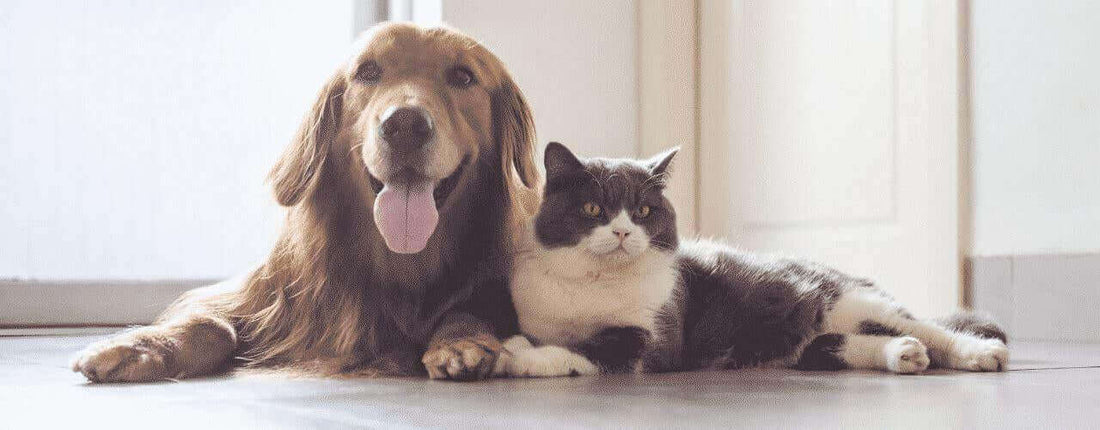
Treat Feeding Guide for Dogs and Cats
When it comes to our loved ones, who can resist the pull of puppy eyes and cute purrs?
Although loving pet parents may want to give their cats and dogs everything their little hearts desire, it’s important to lean on the side of caution and not feed too many treats to your pets.
Why?
Like most things, moderation is key! When we think about the times we decide to treat ourselves, it can be hard to know when enough is enough! For me, this is true when it comes to ice cream and gummy bears.
Many pet parents give treats as rewards, to show affection, or as a replacement for attention without considering the additional calories they’re adding to their pet’s diet and any associated health risks that may come.
Not to worry though! This guide will help you learn how and when it’s time to feed treats, when treats become too much, and what treats you should avoid.

Are Treats a Source of Complete Nutrition?
According to the Association of American Feed Control Officials (AAFCO), treats are not intended to be a source of complete nutrition. “As a rule of thumb, cats and dogs should get no more than 10 percent of their daily calories from treats,” advises Lindsay Tracy, Director of Product Development and New Business at Redbarn Pet Products.
How Many Treats Should I Feed my Cat or Dog Each Day?
Your vet can tell you the total number of calories your cat or dog needs each day. Do the math to get your 10 percent suitable for treats. Then, take a look at the back of your pet’s favorite treats to determine how many calories are in each bite.
If your bag does not have calorie information, it’s considered a “chew” under AAFCO and is not required to share caloric information. However, many chews that are ingested by our dogs, like Bully Sticks, do contain significant calories. You can call the treat manufacturer (like Redbarn!) for specific information.

How Often Should I Treat My Cat or Dog?
Typically, there is no rule about how often you can dole out treats, so long as you stick to the 10 percent rule— limiting treats to 10 percent of their daily calories. Some pet parents choose to give one large treat each day, while others give a handful of small, low calorie treats throughout the day.
Think about it. Giving your dog or cat too many processed treats is much like supplying them with an all-you-can-eat supply of potato chips and candy! This can lead to weight gain and even chronic disease.
“If your fur baby is on a diet for health reasons, always talk to your veterinarian so you know what treats are appropriate to feed,” says Lindsay. “Just like an excessive amount of cookies and cakes won’t balance our diet, too many treats in-between mealtimes are not the best answer for our cats and dogs, either. “
Is it necessary to feed treats to my cat or dog?
Believe it or not, treats are not a dietary requirement for your cat or dog. Yes, this means skipping treats altogether is entirely acceptable (and does not make you a bad pet parent), too. You can still train and love your dogs and cats with simple, meaningful rewards through signs of affection like playtime, cuddles, and praise.

How to Choose Healthy Treats for Your Cat or Dog
When choosing the absolute best treat for your fur baby, seek out trusted companies who are transparent about their sourcing and manufacturing practices. It’s important to know where the ingredients come from, how they are cooked, and how the company protects your pet’s safety through quality assurance tests.
As for the best treat ingredients, you can look for all-natural options or limited or single-ingredient chews. You can also avoid treats made with animal by-products, added sugar, honey or molasses, synthetic preservatives, and artificial flavors and colors. The best treats are made with a clean and simple cooking process, using high-quality beef, chicken, or fish as the first ingredient.
Different Types of Treats for Cats and Dogs
High-Value Rewards
High-value rewards are generally reserved for less-common instances when a dog must receive strong, positive reinforcement to learn. For example, a high-value reward might be used for recall in a crowded area. Examples of high-value rewards include liver, cheese, or anything your dog goes crazy over. If you are training your dog to become a service or emotional support animal, high-value rewards are usually a distraction for the dog and can only be used in certain circumstances.
Training Treats
Training treats are smaller, less calorie-dense dog treats intended for training sessions. These treats are available in a wide variety of flavors, shapes, and sizes.
Redbarn Air Dried Beef Training Treats
Redbarn Air Dried Chicken Training Treats
Biscuits
Dog biscuits are hard, dry treats, and generally fed as snacks or for non-training purposes. These treats can be high in added sugar and artificial flavors, so be sure to decode the label.
Training treats can be given in higher volume if they are around three to five calories each. Air Dried Training Treats are only one to three calories per treat, so pet parents can treat confidently without feeling the need to be restrictive. High-value rewards and dog biscuits should be given sparingly, considering they typically have a higher calorie content.
Use Treats as Rewards in Fun and Fitness
A great way to incorporate treats into your pet’s daily meals is to use them as rewards or during playtime! Using positive reinforcement with treats is one of the most common ways people choose to train their new furry family members.
For example, if you say, “Sit!” and your dog does as you ask, you give them a treat. This is rewarding good behavior.
Toxic Foods Commonly Mistaken for Treats
- Coffee
- Chocolate
- Grapes & Raisins
- Raw dough
- Onions and garlic
- Toxic nuts
Pro-Tip: To avoid serious illnesses, it’s best to keep cats and dogs out of the kitchen when preparing human meals.
Do’s and Don’ts of Treat Feeding
Do
- Consider High-Protein Treats
- Use Treats as a Reward
- Use Treats as a Training Tool
- Use Treats as a Meal Topper
- Ensure Access to Clean Drinking Water
Do Not
- Use Treats As a Complete Meal Replacement
- Use Treats as a Replacement for Real Affection and Love
- Feed Table Scraps or Other Human Foods that may be harmful to your pet
- Feed Dog Treats to Cats or Vise Versa

Bottom Line
Pet parents should aim to make treats special — and rare. What matters most is portion control. This is especially true if your cat or dog is on the heavier side.
We definitely hope this guide comes in handy next time you find yourself wondering, “Am I feeding too many treats?”


